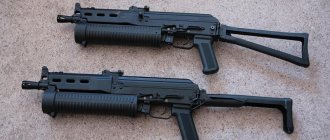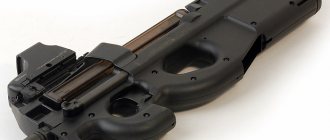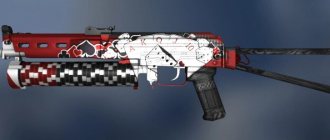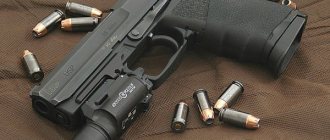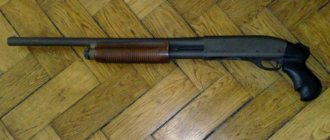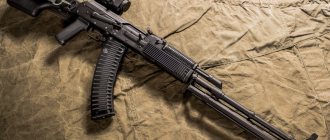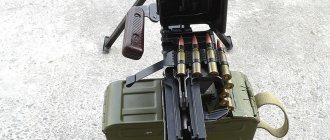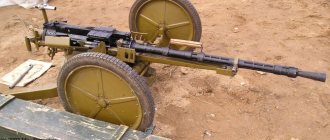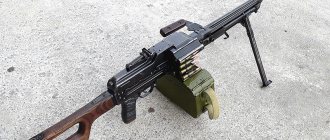OTs-02 (TKB-0217) "Cypress" - a submachine gun, developed in 1972 by order of the USSR Ministry of Defense (R&D "Kustranik") by the designers of TsKIB SOO in Tula N. M. Afanasyev, D. P. Pleshkov and N V. Trukhachev. The layout diagram of the Czechoslovak Scorpion Vz.61 submachine gun of the 1961 model was taken as the basis.
Beginning in 1949, a new type of weapon began to enter service with the Soviet Army - machine guns chambered for the 7.62 mm cartridge of the 1943 model - the so-called “intermediate”. In this regard, submachine guns, which played an extremely important role in the Great Patriotic War, were withdrawn from military use and consigned to oblivion for a long time. But life has shown that automatic, or, according to some classifications, self-firing (as opposed to self-loading), weapons chambered for a pistol cartridge can still have their niche in our time. Therefore, in the early 1970s, as a result of work on the competitive theme “Bouquet,” we received the first samples of a new generation of submachine guns chambered for 9x18 mm PM. One of them was the OTs-02 “Cypress” submachine gun (TKB-0217), developed by the leading designer of the Tula TsKIB SOO Hero of Socialist Labor N.M. Afanasyev, who had previously created a rapid-fire aircraft weapon - the A-12.7 heavy machine gun and, together with N.M. Makarov, the AM-23 aircraft cannon. However, OTs-02 “Cypress” began to be produced only in 1992 for units of the Ministry of Internal Affairs of the Russian Federation.
The fact is that the “Bouquet” theme was soon supplanted by the “Modern” theme, the impetus for the development of which was the work of TsNIITOCHMASH researcher P.A. Tkachev. The designer proved that on the basis of a 5.4 mm machine gun cartridge, light machine guns can be created that are practically no different in weight from submachine guns. The “Modern” theme ended with the creation of the AKS-74U assault rifle in Izhevsk. Due to the desire for maximum unification with the full-size AK-74, this weapon acquired a rather ugly appearance. Despite the fact that the AKS-74U, produced in large quantities, came into service with many law enforcement agencies, by the beginning of the 1990s, the Ministry of Internal Affairs considered it expedient to return to submachine guns. Later, the army also became interested in these weapons. As a result, by the beginning of the 2000s, the gunsmiths of Tula, Kovrov and Izhevsk had produced many models of submachine guns, fiercely competing with each other.
The OTs-02 “Cypress” submachine gun (TKB-0217) is a personal weapon of attack and defense, belonging to the class of light submachine guns. Its automatic operation, like that of almost all submachine guns, is based on the free-breech operating principle. In other words, the barrel bore is locked by an inertial bolt. However, unlike the vast majority of types of these weapons, it fires from the front sear, and the primer of the cartridge sent into the chamber is broken by the trigger mechanism. This allows you to fire a well-aimed first shot and significantly reduce the spread of hits when firing with single fire compared to weapons where shooting is carried out from the rear sear.
The next feature of the OTs-02 “Cypress” submachine gun (TKB-0217) is the presence of a device that slows down the rate of fire due to the bolt being in the rearmost position. According to research by English gunsmiths, the optimal rate of fire is about 450 rounds per minute, which makes it easy to control the weapon. But technically this is difficult to achieve. For example, the Israeli Micro-Uzi has 1250 rpm, the American Ingrem has 1200 rpm, and the Izhevsk Klin has up to 1200 rpm. This rate of fire negatively affects both the controllability of the weapon and the dispersion of hits. The next feature of the OTs-02 “Cypress” (TKB-0217) is the presence of an anti-rebound mechanism, which is a massive inertial body that moves freely in the shutter cavity.
The general layout of the submachine gun is the same as that of the Czechoslovak Scorpion submachine gun, known since the early 60s of the last century. This arrangement is characterized by the location of the fire control handle at the butt plate of the bolt box, the magazine in front of the trigger guard and the shoulder rest, which is placed by turning up and down on the top of the bolt box cover. The trigger mechanism is made in the form of a separate assembly, hingedly connected to the bolt box. The cocking handle is located on the right. On the left side of the bolt box there is a safety switch for the fire mode, allowing convenient control with the thumb of the right hand.
Sights consist of a two-position rear sight for shooting at distances of 25 and 75 meters, mounted on the rear of the bolt box, and a front sight. The part of the barrel protruding forward from the bolt box is smooth and cylindrical. It does not have a muzzle compensating, brake or flash suppressor attachment. It can be fitted with a silencer for low-noise and low-flame shooting. When installing a muffler, the front sight automatically rises. The cartridges are fed from straight box magazines with a capacity of 10, 20 and 30 rounds with their staggered arrangement and double-row exit. Spent cartridges are reflected upwards. When the cartridges are used up, the bolt stops in the rear position at the bolt stop. On the left side of the submachine gun body there are two swivels for the shoulder strap.
There is a variant of the submachine gun with a built-in silencer and a laser designator specially developed for it.
When firing from the OTs-02 "Kiparis" (TKB-0217) submachine gun with 9x18 mm 7N25 cartridges developed at KBP (which have the same ballistic impulse as the PM pistol cartridges), the characteristics of penetration of solid obstacles at distances up to 50 meters higher than similar weapons chambered for the 9x19 Parabellum cartridge.
What's special?
According to experts, the peculiarity of the Cypresses is the presence of special devices that slow down the rate of fire. Despite the fact that an Israeli-made ultrasound can fire 1,250 rounds per minute, and the American Ingrem and Izhevsk Klinov can fire 1,200 rounds each, many military experts are convinced that 450 rounds per minute is considered the most optimal for a weapon of this class, since it is easier for a fighter to control. The Cypress is also equipped with a special anti-rebound device - a massive inertial body that can move freely in the bolt cavity.
Reliability of "Vepr-308"
Despite the impeccable reputation of the Vepr-308 Super, hunters note in reviews that the weapon rarely misfires after the second shot. When this happens, the shooter jerks the bolt, the cartridge falls out, and the next ammunition that enters the chamber also misfires. The capsules remain intact. This problem is solved by filing off the burrs on the sear.
Breakage of the firing pin, based on hunter reviews of the Vepr-308 Super, occurs no earlier than 2500 rounds have been fired, which is a very good result for this category of guns.
Despite the above problems of the rifle, it is one of the best and relatively inexpensive types of firearms designed for hunting medium and large animals. Vepr series carbines are often used to improve shooting skills.
About the history of creation
In the early 1970s, the Soviet army leadership became interested in the topic of compact weapons designed specifically for elite security forces. As part of the Bouquet project, gunsmiths began to develop a small-sized submachine gun. At the same time, in Izhevsk, the Soviet designer of the Central Research Institute TochMash P.A. Tkachev improved the legendary AK on the topic “Modern”. Soon the gunsmith assembled a light machine gun chambered for a 5.4 mm machine gun cartridge. The unified rifle unit is listed in the technical documentation as AKS-74U and weighs no more than a submachine gun.
The “Bouquet” theme was relegated to the background. The assault rifles began to be produced in large quantities and supplied to law enforcement agencies. Nevertheless, the AKS-74U turned out to be quite ugly, and the leadership of the Ministry of Internal Affairs returned to the “Bouquet” theme, namely to submachine guns.
Excerpt characterizing OTs-02
Beretta pneumatic pistol: technical characteristics, reviews and photos
The brother shook his head in disbelief. “The one thing that’s hard for me, I’ll tell you the truth, Andre, is my father’s way of thinking in religious terms. I don’t understand how a person with such a huge mind cannot see what is clear as day and can be so mistaken? This is my only misfortune. But here, too, lately I have seen a shadow of improvement. Lately his ridicule has not been so caustic, and there is one monk whom he received and spoke to him for a long time. “Well, my friend, I’m afraid that you and the monk are wasting your gunpowder,” said Prince Andrei mockingly but affectionately. - Ah! mon ami. I just pray to God and hope that He will hear me. Andre,” she said timidly after a minute of silence, “I have a big request to ask of you.” - What, my friend? - No, promise me that you won’t refuse. It will not cost you any work, and there will be nothing unworthy of you in it. Only you can console me. Promise, Andryusha,” she said, putting her hand into the reticule and holding something in it, but not yet showing it, as if what she was holding was the subject of the request and as if before receiving the promise to fulfill the request, she could not take it out of the reticule It is something. She looked timidly and pleadingly at her brother. “Even if it cost me a lot of work...”, answered Prince Andrei, as if guessing what was the matter. - Think whatever you want! I know you are the same as mon pere. Think what you want, but do it for me. Do it please! My father’s father, our grandfather, wore it in all the wars...” She still didn’t take what she was holding out of the reticule. - So you promise me? - Of course, what's the matter? - Andre, I will bless you with the image, and you promise me that you will never take it off. Do you promise? “If he doesn’t stretch his neck by two pounds... To please you...” said Prince Andrei, but at that very second, noticing the distressed expression that his sister’s face took on at this joke, he repented. “Very glad, really very glad, my friend,” he added. “Against your will, He will save and have mercy on you and turn you to Himself, because in Him alone there is truth and peace,” she said in a voice trembling with emotion, with a solemn gesture holding in both hands in front of her brother an oval ancient icon of the Savior with a black face in silver chasuble on a silver chain of fine workmanship. She crossed herself, kissed the icon and handed it to Andrey. – Please, Andre, for me... Rays of kind and timid light shone from her large eyes. These eyes illuminated the entire sickly, thin face and made it beautiful. The brother wanted to take the icon, but she stopped him. Andrei understood, crossed himself and kissed the icon. His face was at the same time tender (he was touched) and mocking. - Merci, mon ami. She kissed his forehead and sat down on the sofa again. They were silent. “So I told you, Andre, be kind and generous, as you always have been.” Don’t judge Lise harshly,” she began. “She is so sweet, so kind, and her situation is very difficult now.” “It seems that I didn’t tell you anything, Masha, that I should blame my wife for anything or be dissatisfied with her.” Why are you telling me all this? Princess Marya blushed in spots and fell silent, as if she felt guilty. - I didn’t tell you anything, but they already told you. And it makes me sad. Red spots appeared even more strongly on Princess Marya’s forehead, neck and cheeks. She wanted to say something and could not say it. The brother guessed right: the little princess cried after dinner, said that she foresaw an unhappy birth, was afraid of it, and complained about her fate, about her father-in-law and her husband. After crying, she fell asleep. Prince Andrei felt sorry for his sister. - Know one thing, Masha, I cannot reproach myself for anything, I have not reproached and will never reproach my wife, and I myself cannot reproach myself for anything in relation to her; and it will always be so, no matter what my circumstances. But if you want to know the truth... do you want to know if I'm happy? No. Is she happy? No. Why is this? I don’t know... Saying this, he stood up, walked up to his sister and, bending down, kissed her on the forehead. His beautiful eyes shone with an intelligent and kind, unusual sparkle, but he looked not at his sister, but into the darkness of the open door, over her head. - Let's go to her, we need to say goodbye. Or go alone, wake her up, and I’ll be right there. Parsley! - he shouted to the valet, - come here, clean it up. It's in the seat, it's on the right side. Princess Marya stood up and headed towards the door. She stopped. – Andre, si vous avez. la foi, vous vous seriez adresse a Dieu, pour qu'il vous donne l'amour, que vous ne sentez pas et votre priere aurait ete exaucee. - Yes, is that so! - said Prince Andrei. - Go, Masha, I’ll be right there. On the way to his sister’s room, in the gallery connecting one house to another, Prince Andrei met the sweetly smiling Mlle Bourienne, who for the third time that day had come across him with an enthusiastic and naive smile in secluded passages.
About performance characteristics
- The Cypress pistol was developed in 1972.
- In service with the special forces of the Russian Ministry of Internal Affairs since 1992.
- A rifle unit with 30 rounds of ammunition without PBS and laser designator weighs 1.6 kg. With a full 20-round magazine, a device for silent shooting and a target designator - 2.6 kg.
- The length of the pistol barrel is 15.6 cm.
- The total length of the 9 mm submachine gun (without silencer and stock) does not exceed 31.7 cm.
- With a silencer and an open butt, the size of the weapon is 73 cm, with a folded butt and attachment - 45.2 cm, with an open butt and without a silencer - 59.5 cm.
- The weapon is equipped with 9x18 mm Makarov pistol cartridges.
- Within one minute, this model can fire from 850 to 900 shots.
- The fired projectile moves at a speed in the range of 320-335 m/s.
- Aimed fire is possible at a distance of up to 75 m.
- Equipped with clips of 10, 20 and 30 ammunition.
Beneficial properties of edible chestnut nut
As a fruit species, chestnuts are of great value: they are eaten raw, fried, baked, made into flour, butter, jam, coffee, and used in the preparation of confectionery. Raw chestnut fruits are very nutritious, have a high content of proteins and carbohydrates, they contain vitamins B, C, malic and citric acids. The raw kernel of the large-fruited Azerbaijani chestnut nut contains (in%): water 55.46% water, 28.22% carbohydrates, 4.39% protein and 1.36% fat. Small-fruited - 32.82% water, 47.29% carbohydrates, 4.62% protein and 1.68% fat. Green and yellowed chestnut leaves are also considered medicinal: 1 gram of fresh leaves contains 800 biological units of vitamin K (dried leaves - about 600). Chestnut plays a great role in beekeeping - unique chestnut honey is very tasty and healthy. But in addition to the fruits, the wood of this tree is of great value. It has a beautiful structure, is easy to process, is resistant to rotting, is used for making furniture, musical instruments, in construction, is used for plywood, riveting, etc. It is valued on a par with oak. That is why chestnut groves in the North Caucasus suffered (and are still suffering) greatly from illegal logging.
How does the weapon work?
"Cypress", the photo of which allows you to get an idea of its appearance, like all submachine guns, is equipped with automatic blowback action. The TKB-0217 differs from other rifle models of this class in that it fires from the front sear, and the capsule breaks the trigger mechanism. Due to this, the fighter can fire an aimed first shot. Also, when firing single shots, the spread is minimized, which cannot be said about weapons firing from the rear sear. Ammunition is fed into the chamber from straight box-type clips. Pistol magazines are available in three versions: 10, 20 and 30 rounds. They are arranged in a checkerboard pattern. Double row exit. Extraction of used cartridges is carried out upward. After the ammunition is used up, the bolt moves to the rear position.
The most common types of cypress
Gun "vepr": description, characteristics, range, photos and reviews
The following types of cypress trees are most often grown as a garden crop.
Evergreen cypress (Cupressus sempervirens)
Adult forms grow up to 30 meters tall, approaching an age of 2000 years. Young trees have a pointed crown, which becomes columnar as it grows, and the crown becomes rounded. Trees with a pyramidal crown are called pyramidal cypress.
Arizona cypress (Cupressus arizonica)
Cupressus arizonica is smaller in size than the previous species, but more frost-resistant. Unpretentious, can grow on dry alkaline soils. The color of the needles is light green. Excellent for forming hedges.
Large-fruited cypress (Cupressus macrocarpa)
This species grows faster than its predecessors and is resistant to sea winds. Therefore, it is used for forest shelterbelts, planted near the banks. The root system is powerful, requiring a greater depth of fertile soil.
Swamp cypress (Taxodium distichum)
Taxodium distichum has another name - taxonium biserialis. This is an amazing plant.
Wild specimens reach colossal sizes: about 36 meters high, and the trunk diameter is 1 – 3 meters. Individual trees were observed whose trunk diameter was 5 meters.
A significant difference from other species is that it is deciduous. Thick, ten-centimeter bark, red-brown in color, furrowed with longitudinal cracks.
Taxonium is two-rowed, prefers moist, marshy places. This species has root outgrowths - pneumatophores, shown in the photo below. They help the tree breathe during flooding. The outgrowths can rise above 1 - 2 meters above the ground and have a cone-shaped shape. It is interesting that pneumatophores are not always formed, but only if there is swampiness.
Description of large-caliber submachine guns
The open-type sight provides targeted shooting at a distance of up to 75 m. The submachine gun has a non-automatic safety blocking the trigger and bolt. 9mm PM cartridges are used for shooting. A silencer can be mounted on the barrel of a submachine gun.
The magazines are similar to the “Wedge”, their capacity is 10, 20 and 30 rounds. When shooting from a rest without a stock at a distance of 25 m, bullets from one burst are placed in a circle with a radius of 67 mm, and most of the hits are 28 mm. In terms of ease of handling and shooting accuracy, the “Cypress” is superior to the “Wedge”. But “Cypress” has many milled parts, so its production is more expensive than the “stamped” “Wedge”. This was one of the reasons for the adoption of the “Klin” into service. As befits Russian weapons, “Klin” and “Cypress” are reliable, easy to disassemble and clean. Height with a magazine for 20 rounds is 172 mm, for 30 rounds – 226 mm.
Performance characteristics:
| Caliber, mm | 9 reps |
| Length with butt, mm | 590 |
| Length without stock, mm | 318 |
| Magazine capacity, cartridges | 10, 20, 30 |
| Type of fire | He |
| Rate of fire, rds/min | 600 – 900 |
PP-19 "Bison"
It is noteworthy that the development of weapons was carried out by the sons of such great designers as M.T.
Kalashnikov is the creator of the legendary AK (by Viktor Mikhailovich), and E.F. Dragunov, who designed the SVD (by Alexey Evgenievich). "Bison" was developed by order of the Ministry of Internal Affairs of the Russian Federation. The weapon, although still chambered for the same 9x18 mm cartridge, turned out to be much more effective than the Kedr.
Such good quality was achieved due to the unification of spare parts with the AKS-74U, with which the Bison has over 50% of common parts, including the receiver. A characteristic, rather rare design solution among domestic SMGs is the presence of an under-barrel auger magazine for 64 rounds.
PP-19 "Bison-2"
The tactical and technical characteristics are impressive: with a mass of various modifications ranging from 2.7 to 3.2 kg, the effective firing range ranges from 100 (for models with 9x18 mm PM) to 200 meters (for 9x19 Parabellum and 7.62x25 mm TT). There are about 13 different modifications, including the Vityaz PP in three different versions.
The PP has an open sight; on the left side there is a mount for sighting devices. It is in service with the FSB, FSIN, special forces of the Russian Guard and the Ministry of Internal Affairs, bailiffs, and couriers. Abroad adopted for service in Venezuela, North Korea, Vietnam, Bosnia and Herzegovina.
Notes[edit]
- ↑ “Cypress” // Blagovestov A.I.
What they shoot from in the CIS: Directory of small arms. / under. general ed. A.E. Taras. Mn.: “Harvest”, 2000. p.212-214 - I. Skrylev. Security guard equipment, gas weapons // Security World magazine, February 1998, pp. 54-56.
- “ 9 mm submachine guns... OTs-02 (TKB-0217) “Cypress”
“Appendix No. 2 to Order of the Ministry of Internal Affairs of Russia No. 173 of February 17, 2001 “List of individual types and models of combat hand-held small arms, service and civilian weapons, cartridges for it, used by employees of paramilitary and guard units of private security under the internal affairs bodies" - Decree of the Government of the Russian Federation No. 1436 of December 30, 1999 “On special means and firearms used by departmental security” (as amended on February 11, 2003)
- Decree of the Government of the Russian Federation No. 460 of April 22, 1997 “On measures to provide legal entities with special statutory tasks with combat hand-held small arms”
Review
A senior sergeant of military intelligence, who used the weapon in several combat operations, left the following review: “A small-sized weapon with high fire power. An experienced shooter can quickly release the entire magazine at the intended target. The low weight allows you to shoot with one hand, without compromising accuracy. The advantage is the ability to use a silencer and a laser designator. I used a copy that allowed me to mount either a laser target or a muffler. On later models the flaw was eliminated. The required module is attached to the latch easily and quickly.
The shoulder rest is made at a high level. It will take some practice to hit the target, as sometimes poor shoulder support can affect accuracy. The recoil when firing is small and can be easily dealt with. After each use, I recommend tightening the stop mechanism, as it becomes loose during shooting. The magazine button works clearly and without jamming.
To quickly cock the bolt, training will be required due to the cocking handle, which is not placed in the most convenient place. To cock the bolt, you must not only pull the handle, but also push it in first, and then remember to return it to its original position. If the process is performed incorrectly, then after the shot you can damage your fingers with the handle, which will return to its original position. The flat shape of the safety catch does not allow you to quickly change the fire mode while wearing gloves.”
Similar chapters from other books:
Chapter 14. Machine gun in the air and at sea
Chapter 14 The Machine Gun in the Air and at Sea There are vast and very obvious differences between the fighter aircraft of 1918 and its equivalent in 1939; Over the past two decades, aircraft engines and aircraft designs have come a long way. New
6-mm “UNIFIED” MACHINE GUN AND MACHINE GUN
6mm "UNIFIED" MACHINE GUN AND MACHINE GUN These two weapon systems are described together because they have never appeared separately in Russian literature or at arms exhibitions. Both systems were developed at TsNIITochmash and began to appear at international
MAKAROV PISTOL AND ITS DERIVATIVES
The MAKAROV PISTOL AND ITS PM DERIVATIVES, developed as a replacement for the Tokarev TT-33 pistol chambered for 7.62x25 mm, was adopted by the Soviet Union in 1951. The main task when creating a new pistol was to provide easier control during frequent use.
SMALL-SIZED PISTOL PSM
SMALL-SIZED PSM PISTOL “The self-loading small-sized pistol,” known in the West under the designation PSM, is one of those models of Russian weapons that, although they appeared quite a long time ago, only recently became known to Western experts.
SMALL-SIZED GUN “BAIKAL-441”
SMALL-SIZED PISTOL "BAIKAL-441" Realizing that the PSM would never be able to overcome the strict restrictions on the import of weapons adopted in Western countries, especially in the United States, the designers set a goal to fit the PSM under the terms of the Control Act
PISTOL "BAIKAL-442"
BAIKAL-442 PISTOL The Baikal-442 was another attempt to penetrate the American gun market, and if the Clinton Administration had not banned the import of Russian pistols, the Baikal-442 would likely have achieved very high sales levels. In fact
SILENT PISTOL S4M 7.62×62.8 mm
SILENT PISTOL S4M 7.62×62.8 mm Same as the MSP silent pistol. S4M appeared in the early 70s, but it has a more complex design. According to the principle of operation, the ammunition used in this pistol is similar to the ammunition for the SME, but its execution is completely different.
PISTOL OTs-27 "BERDYSH"
PISTOL OTs-27 "BERDISH" OTs-27 is another unusual pistol developed by the Tula KBP. The original design was a multi-caliber weapon, from which, by changing two barrels and two magazines, it was possible to fire 9x18 mm cartridges. 9x18 mm modernized, 9x19 mm and 7.62x25
PISTOL OTs-23 “DART” 5.45×18 mm
PISTOL OTs-23 “DARTIK” 5.45×18 mm The fully automatic pistol OTs-23 “Dartik” was developed by the Tula KBP. The general concept is taken from the Stechkin pistol created in the 50s, according to representatives of the Tula KBP, which is still produced in limited quantities, but only in
PISTOL OTs-33 “PERNACH”
PISTOL OTs-33 “PERNACH” OTs-33 is very similar to the OTs-23 described above, but it only has a different caliber and a different design of the bolt casing. The OTs-33 bolt closes the hole for ejecting the spent cartridge case, unlike the open OTs-23 bolt. According to representatives of the Tula
PISTOL P-96 9×19 mm
PISTOL P-96 9×19 mm The Tula pistol P-96 is the first representative of a new generation of Russian pistols. Unlike the Gyurza, which is chambered for its own cartridge and in its current form does not have reliable safety features, the P-96 seems to
SUBMACHINE PISTOL "BAKSAN"
“BAKSAN” SUB-MACHINE GUN There is very little literature about “Baksai”; the submachine gun has never been demonstrated in hardware. There is little doubt that the Baksan is a candidate for Russia's "personal defense weapon", a concept put forward several years ago
SUBMACHINE GUN "CHEETHAH"
"CHEETHA" SUB-GUN The experimental "Cheetah" submachine gun is also based on the Kalashnikov assault rifle, but it is highly unusual because, with minor modifications, it can fire at least five different types of cartridges.
SUBMACHINE GUN OTs-22
SUBMACHINE GUN OTs-22 OTs-22 is a very light and small-sized submachine gun designed by the Tula KBP, chambered for a 9x19 mm cartridge, somewhat reminiscent of the Ingram. In addition, it is very similar to the AEK-919K submachine gun described above. There is practically nothing about this weapon
SUBMACHINE GUN PP-93 9×18 mm
SUBMACHINE GUN PP-93 9×18 mm PP-93 can be considered as a non-folding modification of the PP-90 described above. Both submachine guns are produced by the Tula KBP, and both have almost the same internal structure. So. for example, both designs use
Submachine gun "Spectrum"
Submachine gun "Spectrum" But despite all the apparent simplicity, the design of the "Spectrum" has several very useful new items. The PP design ensures the tightness of the bolt box, reliably protecting the mechanism from contamination. Trigger mechanism
Getting to know the rifle unit
"Cypress" is a weapon for attack and defense. Classified as a light submachine gun. The Cypress OTs-02 weapon was developed at the Tula TsKIB SOO by order of the Ministry of Defense of the Soviet Union. The author is Hero of Socialist Labor N. M. Afanasyev. He is also the creator of the A-12.7 heavy machine gun and the AM-23 aircraft gun (the latter model was developed jointly with N. M. Makarov). OTs-02 “Cypress” is a weapon with a layout identical to the Czechoslovakian Vz.61 Scorpion submachine gun produced in 1961.
OTs-02 - Wikipedia
Material from Wikipedia - the free encyclopedia
The current version of the page has not yet been verified by experienced participants and may differ significantly from the version verified on July 10, 2018; checks require 3 edits. The current version of the page has not yet been verified by experienced participants and may differ significantly from the version verified on July 10, 2018; checks require 3 edits. Skip to navigation Skip to search For this term there is an abbreviation “OC”, which has other meanings: see OC. There is an abbreviation for this term "TCB", which has other meanings: see TCB.
| OTs-02 "Cypress" |
en.wikipedia.org
Flaws.
The magazine capacity is insufficient for short-range automatic weapons. The large steepness of the trajectory makes it difficult to select an aiming point, especially when shooting at maximum range. The special SP-5 and SP-6 cartridges used are very scarce. Their large mass limits the ammunition they can carry.
Elastic deformation of an insufficiently rigid butt when firing in bursts increases the dispersion of bullets. A high rate of fire contributes to the barrel moving away from the aiming line and rapid consumption of ammunition.
Submachine gun "WEDGE"
The KLIN submachine gun is intended for arming the units of the Ministry of Internal Affairs in the fight against organized crime.
It is a modified version of the Kedr submachine gun chambered for the 9x19 Parabellum cartridge. The production of the pilot series began in 1994.
Thanks to the new cartridge, the effectiveness of the submachine gun has increased significantly. The penetration effect has increased: at a distance of 20 m, the bullet of the modernized cartridge pierces a steel sheet 3 mm thick. The accuracy of fire has been significantly improved: at a distance of 150 m, the transverse dispersion during single firing is less than 80 mm (a standard cartridge at the same range has a dispersion of more than 200 mm). The flat trajectory of the bullet of the modernized 9-mm cartridge allows shooting at a distance of up to 150 m with a constant sight setting.
| Characteristics of the "WEDGE" submachine gun | |
| Caliber, mm | |
| Cartridge used | 9×19 Pair |
| Weight with empty magazine for 30 rounds, kg | 1,54 |
| Length with stock folded, mm | |
| Barrel length, mm | |
| Magazine capacity, cartridges | 20 or 30 |
| Rate of fire, v/m | 975-1060 |
| Sighting range, m |
When creating the “Klin” submachine gun, the basic design solutions of the “Kedr” submachine gun were retained, ensuring its high combat and performance qualities: a trigger mechanism with a break in contact between the hammer and the bolt; combined sighting device; a safety lock that blocks the trigger and bolt.
The increased recoil energy required measures to reduce the rate of fire. This is achieved by increasing the mass of the bolt and applying helical grooves in the chamber, which increase the resistance when extracting the cartridge case, and therefore the time of movement of the bolt. There are other changes.
The weapon can also be fired with standard 9x18 mm cartridges, while the rate of fire is noticeably reduced.
The methods of disassembly, assembly and maintenance are completely identical to those of the Kedr submachine gun.
Submachine gun "KLIN-2"
The design of the Klin-2 submachine gun is a new word in the history of domestic design. The main feature of Klin-2 is the use of so-called balanced automation, that is, reducing the recoil impulse by creating synchronous and opposite movement of two inertial masses. The role of these two masses is performed by the movable barrel and bolt frame.
When fired, a recoil moment is created, causing the bolt group to roll back to the rear wall of the receiver. At the same moment, following the movement of the powder gases and the bullet, the barrel begins to slide forward. This design ensures the simultaneous achievement of the extreme points of the two masses, which thus generate dynamic moments of opposite magnitudes. This solution not only improves accuracy characteristics, but also increases shooting comfort and reduces fatigue when conducting intense fire.
| Characteristics of the Klin-2 submachine gun | |
| Caliber, mm | 7,62 |
| Cartridge used | 7.62x25 TT |
| Weight with magazine without cartridges, kg | . |
| – with a magazine for 20 rounds | 1,63 |
| – with a magazine for 30 rounds | 1,67 |
| Length, mm | . |
| – with folded butt | |
| – with the butt folded down | |
| Barrel length, mm | |
| Rate of fire, rds/min | |
| Initial bullet speed, m/s | . |
| – without low-noise shooting device | |
| – with a low-noise shooting device |
Submachine gun OTs-22 (9x19 mm Parabellum cartridge), developed by TsKIB SOO (Tula)
| Characteristics of OTs-22 | |
| Caliber, mm | |
| Cartridge used | 9×19 Pair |
| Weight, kg | 1,3 |
| Length, mm | |
| – with folded butt | |
| – with the butt folded down | |
| Magazine capacity, cartridges | 20 or 30 |
| Rate of fire, rds/min | |
| Sighting range, m |
Call of Duty: Black Ops[]
| "Cypress" | |
| Damage | 30-20 (MP) |
| Opens | After purchasing all PP |
| Price | 2000 |
| Shop | 20 (30 Large store) |
| Starting ammunition | 60+20 rounds |
| Reload | 2.1s (2.65s empty)1.3 real |
| Rate of fire | 937.5 shots/min. |
| Recoil | Average |
| Mobility | 100% |
| Penetration ability | Medium (Low when installing the Dual Wield module) |
| Fire mode | Auto |
| A country | |
| Used | SpetsnazGrigory Weaver |
| Pick icon |
Single player game
In a single-player game, many Special Forces will be armed with Cypress. Very often this PP will come across in Numbers missions, and most often with a Large Magazine. A paired version can be found in Clark's stash. Will also be found in the Revival mission. In single player, it has slightly lower recoil (compared to multiplayer) and slightly stronger damage, but it still kills slowly.
Online game
This SMG is unlocked after purchasing all other submachine guns (not earlier than level 41) and costs 2000 CoD Points. Therefore, it is more difficult to find among players than other secret weapons. This is also influenced by the fact that the AK-74u dominates in the PP class.
"Cypress" has strong but controllable recoil (swings from side to side and back), high rate of fire, standard damage (30-20), small magazine (only 20 rounds). An additional disadvantage is that the cartridges ejected during a shot “jump” upward from the barrel, which greatly interferes with aimed shooting. These parameters make it similar to MAC11, but the only difference is that the latter has lower returns, although they are random. That is why it is very difficult to meet him among players. This weapon is quite rare because To purchase it you need to buy all PP.
Adviсe
The most practical advice that can be given regarding Cypress is to learn how to do “reload canceling,” that is, completing the reload before its visual end. In this parameter, the Cypress outperforms all SMGs in Black Ops, and using this fact, you can make it the fastest weapon to reload. You can see what it roughly looks like in the video gallery.
Because of these shortcomings, it is best to use the Large Magazine and the Handle, combining them with the Gunsmith and Marauder perks. Moreover, the reload time is not that long.
You can also use “Cypress” with Ready and “akimbo” - it turns out quite well, but this is for fans of dual weapons.
Oddly enough, you can use Cypress with Rate of Fire. It’s just that the barrel won’t have time to move very upward when the player has already used up the magazine. However, you should not forget that you are unlikely to have enough magazine for even a double kill (and sometimes even a single one), so the Sleight of Hand and Marauder perks are required. What this leads to - watch the video gallery...
Required Skills
Small Arms: Expert
- level3
168000
Small Arms: Specialist
- Level
5
150000
Small Arms: Novice
- Level
5
25000
Accuracy: Novice
- Level
3
7000
Damage:
- Level
3
7000
Accuracy
Level
5
25000
Damage: Novice
- Level
5
25000
Accuracy: Specialist
- Level
2
18000
Accuracy: Novice
- Level
4
14000
Damage: Specialist
- Level
2
18000
Damage: Novice
- Level
4
14000
Note.
The numbers in the superscript are the total experience for taking the skill, including previous levels. The number is absolute, i.e. it is indicated without character discounts for characteristics above 10.
| Required Experience | Components |
| Primary parameter | Secondary parameter |
| 429000 396825 |
|
| 5.16 … 9.96 | |
| Incendiary: | 3.7 … 9.96 |
| Chemical: | 1.13 … 6.37 |
| Electromag.: | 1.85 … 12.03 |
| Incendiary: | 1.54 … 5.11 |
| Chemical: | 0.81 … 5.12 |
| Electromag.: | 0.4 … 4.89 |
| Incendiary: | 2.56 … 7.65 |
| Chemical: | 0.81 … 5.12 |
| Electromag.: | 0.73 … 7.41 |
| 3.68 … 7.65 | |
| Incendiary: | 2.45 … 7.41 |
| Chemical: | 0.66 … 4.42 |
| Electromag.: | 1.34 … 10.41 |
| Incendiary: | 1.02 … 3.6 |
| Chemical: | 0.54 … 3.78 |
| Electromag.: | 0.26 … 3.44 |
| Incendiary: | 1.77 … 5.75 |
| Chemical: | 0.54 … 3.78 |
| Electromag.: | 0.47 … 5.47 |
| 2.78 … 6.05 | |
| Incendiary: | 1.77 … 5.75 |
| Chemical: | 0.47 … 3.38 |
| Electromag.: | 0.98 … 8.82 |
| Incendiary: | 0.77 … 2.81 |
| Chemical: | 0.41 … 3.07 |
| Electromag.: | 0.19 … 2.65 |
| Incendiary: | 1.3 … 4.43 |
| Chemical: | 0.38 … 2.86 |
| Electromag.: | 0.33 … 4.19 |
| 2.17 … 4.89 | |
| Incendiary: | 1.36 … 4.6 |
| Chemical: | 0.35 … 2.63 |
| Electromag.: | 0.73 … 7.41 |
| Incendiary: | 0.65 … 2.4 |
| Chemical: | 0.35 … 2.69 |
| Electromag.: | 0.16 … 2.28 |
| Incendiary: | 1.16 … 4.04 |
| Chemical: | 0.35 … 2.63 |
| Electromag.: | 0.29 … 3.78 |
| 1.72 … 3.97 | |
| Incendiary: | 1.06 … 3.71 |
| Chemical: | 0.26 … 2.08 |
| Electromag.: | 0.58 … 6.38 |
| Incendiary: | 0.5 … 1.88 |
| Chemical: | 0.27 … 2.12 |
| Electromag.: | 0.12 … 1.77 |
| Incendiary: | 0.91 … 3.24 |
| Chemical: | 0.26 … 2.08 |
| Electromag.: | 0.22 … 3.03 |
Similar chapters from other books:
Chapter 14. Machine gun in the air and at sea
Chapter 14 The Machine Gun in the Air and at Sea There are vast and very obvious differences between the fighter aircraft of 1918 and its equivalent in 1939; Over the past two decades, aircraft engines and aircraft designs have come a long way. New
6-mm “UNIFIED” MACHINE GUN AND MACHINE GUN
6mm "UNIFIED" MACHINE GUN AND MACHINE GUN These two weapon systems are described together because they have never appeared separately in Russian literature or at arms exhibitions. Both systems were developed at TsNIITochmash and began to appear at international
MAKAROV PISTOL AND ITS DERIVATIVES
The MAKAROV PISTOL AND ITS PM DERIVATIVES, developed as a replacement for the Tokarev TT-33 pistol chambered for 7.62x25 mm, was adopted by the Soviet Union in 1951. The main task when creating a new pistol was to provide easier control during frequent use.
SMALL-SIZED PISTOL PSM
SMALL-SIZED PSM PISTOL “The self-loading small-sized pistol,” known in the West under the designation PSM, is one of those models of Russian weapons that, although they appeared quite a long time ago, only recently became known to Western experts.
SMALL-SIZED GUN “BAIKAL-441”
SMALL-SIZED PISTOL "BAIKAL-441" Realizing that the PSM would never be able to overcome the strict restrictions on the import of weapons adopted in Western countries, especially in the United States, the designers set a goal to fit the PSM under the terms of the Control Act
PISTOL "BAIKAL-442"
BAIKAL-442 PISTOL The Baikal-442 was another attempt to penetrate the American gun market, and if the Clinton Administration had not banned the import of Russian pistols, the Baikal-442 would likely have achieved very high sales levels. In fact
SILENT PISTOL S4M 7.62×62.8 mm
SILENT PISTOL S4M 7.62×62.8 mm Same as the MSP silent pistol. S4M appeared in the early 70s, but it has a more complex design. According to the principle of operation, the ammunition used in this pistol is similar to the ammunition for the SME, but its execution is completely different.
PISTOL OTs-27 "BERDYSH"
PISTOL OTs-27 "BERDISH" OTs-27 is another unusual pistol developed by the Tula KBP. The original design was a multi-caliber weapon, from which, by changing two barrels and two magazines, it was possible to fire 9x18 mm cartridges. 9x18 mm modernized, 9x19 mm and 7.62x25
PISTOL OTs-23 “DART” 5.45×18 mm
PISTOL OTs-23 “DARTIK” 5.45×18 mm The fully automatic pistol OTs-23 “Dartik” was developed by the Tula KBP. The general concept is taken from the Stechkin pistol created in the 50s, according to representatives of the Tula KBP, which is still produced in limited quantities, but only in
PISTOL OTs-33 “PERNACH”
PISTOL OTs-33 “PERNACH” OTs-33 is very similar to the OTs-23 described above, but it only has a different caliber and a different design of the bolt casing. The OTs-33 bolt closes the hole for ejecting the spent cartridge case, unlike the open OTs-23 bolt. According to representatives of the Tula
PISTOL P-96 9×19 mm
PISTOL P-96 9×19 mm The Tula pistol P-96 is the first representative of a new generation of Russian pistols. Unlike the Gyurza, which is chambered for its own cartridge and in its current form does not have reliable safety features, the P-96 seems to
SUBMACHINE PISTOL "BAKSAN"
“BAKSAN” SUB-MACHINE GUN There is very little literature about “Baksai”; the submachine gun has never been demonstrated in hardware. There is little doubt that the Baksan is a candidate for Russia's "personal defense weapon", a concept put forward several years ago
SUBMACHINE GUN "CHEETHAH"
"CHEETHA" SUB-GUN The experimental "Cheetah" submachine gun is also based on the Kalashnikov assault rifle, but it is highly unusual because, with minor modifications, it can fire at least five different types of cartridges.
SUBMACHINE GUN OTs-22
SUBMACHINE GUN OTs-22 OTs-22 is a very light and small-sized submachine gun designed by the Tula KBP, chambered for a 9x19 mm cartridge, somewhat reminiscent of the Ingram. In addition, it is very similar to the AEK-919K submachine gun described above. There is practically nothing about this weapon
SUBMACHINE GUN PP-93 9×18 mm
SUBMACHINE GUN PP-93 9×18 mm PP-93 can be considered as a non-folding modification of the PP-90 described above. Both submachine guns are produced by the Tula KBP, and both have almost the same internal structure. So. for example, both designs use
Submachine gun "Spectrum"
Submachine gun "Spectrum" But despite all the apparent simplicity, the design of the "Spectrum" has several very useful new items. The PP design ensures the tightness of the bolt box, reliably protecting the mechanism from contamination. Trigger mechanism
A submachine gun created in 1972 by order of the USSR Ministry of Defense (R&D “Kustarnik”) by the designers of TsKIB SOO in Tula N. M. Afanasyev, D. P. Pleshkov and N. V. Trukhachev. The layout diagram of the Czechoslovak Scorpion Vz.61 submachine gun of the 1961 model was taken as the basis.
Links
- M. R. Popenker.
Pistols APB • APS • SME • • PL-14 • • PMM • PSM • PSS • • P-96 • GSh-18 • SPS • Strizh • OTs-21 • OTs-23 • OTs-27
Submachine guns OTs-02 • PP-19 • PP-2000 • PP-90 • PP-90M1 • PP-91 • PP-93 • SR-2 • AEK-919K • TKB-0247 Kalashnikov assault rifles • AKM • AKMSU • AK74 • AKS74U • AK-101/102/103/104/105 •
AK-107/108
• AK-9 •
Tiss
•
OTs-14
• AK-12Other machines 80.002 •
A-91
•
AB-5.45/7.62
• AN-94 •
AEK-971
• ADS • APS •
ASM-DT
•
AO-38 • AO-46
•
AO-62
•
-
63
• -
65
•
AO-222
• Val • SR-3 •
TKB-022
•
TKB-059
•
TKB-408
•
TKB-517
• 9A-91Rifles and carbines SKS • KS-23 Sniper rifles SVK • SVD • SVDS • SVU • SVDK •
VS-121
• Vintorez • VSK-94 • SV-98 • SV-99 •
SVL
•
T-5000
• VS-8 • OSV-96 • KSVK • ASVK • VSSK •
TKB-0145K
•
MC-116MMachine guns 6P62 •
AEK-995
•
AEK-999
•
AO-22
•
AO-29
• DShK • SG-43 •
Slostin machine gun
• RPD • RP-46 • RPK • RPK-74 • Pecheneg •
PU-21
•
2B-P-45
• •
TKB-015
•
TKB-264
•
TKB-464
•
TKB-521
•
Turner
• KPV • Kord • NSV-12.7Grenade launchers and rocket-propelled grenades AGS-17 • AGS-30 • AGS-40 • Bur • GM-93/94 • RG-6 • RGS-50 • RPG-1 • RPG-2 • RPG-4 • RPG-7 • RPG-16 • RPG-18 • RPG-22 • RPG-26 • RPG-27 • RPG-28 • RPG-29 • RPG-30 • RPG-32 • SG-82 • SPG-9
Flamethrowers LPO-50 • Lynx • Bumblebee • RShG-1 • RShG-2 ATGM Malyutka • Bassoon • Metis • Cornet MANPADS Strela-2 • Strela-3 • Needle • Willow Guns RMB-93 Hand grenades F-1 • RG-42 • RGD-5 • RPG-43 • RPG-6 • RKG-3 • RDG-2 • RGN • RGO Weapon cartridges 5.45×18 mm • 5.45×39 mm • 6×49 mm • 7.62×39 mm • 7.62×41.5 mm (
7Н36
) • 7.62×54 mm R • 8.6×70 mm • 9×18 mm • 9×19 mm • 9×21 mm • 9×39 mm • 9.3×64 mm • 12.7×55 mm • 12.7×108 mm • 14.5×114 mmItalic experimental (not accepted for service) samples have been identified
Pistols • • • TKB-023 • TKB-160 • TKB-205 • TKB-263 • TKB-412 • • APS • APB • PSM • • OTs-35 • TKB-506 • OTs-21 • OTs-23 • OTs-27 • OTs-33 • P-96 • GSh-18 Submachine guns PPT-27 • LAD • PP-90 • PP-90M1 • TKB-0247 • PP-93 • TKB-0102 • TKB-0104 “Bouquet” • TKB-486 • OTs- 02 • OTs-22 • OTs-36 • OTs -39 “Baksanets” • OTs-53 • PP-2000 • OTs-69 Slot machines TKB-03 • TKB-09 • TKB-010 • TKB-011 • TKB-022 • TKB-059 • TKB-060 • TKB-072 • TKB-0106 • TKB-0110 • TKB-0111 • TKB-0116 • TKB- 0136 • TKB-0144 • TKB-0146 • TKB-408 • TKB-415 • TKB-497 • TKB-454 • TKB-517 • TKB-590 • TKB-790 • OTs-12 • 9A-91 • OTs-14 • A-91 • ADS • ASH-12 Rifles and carbines SVT-38 • SVT-40 • TKB-270 • TKB-392 Hunting rifles and carbines MTs18 • MTs-30 • MTs-106 • MTs-109 • MTs-110 • MTs-111 • MTs-200 • MTs-255 • OTs-18 • OTs-25 • OTs-31 • OTs-51 • OTs-63 Combat and service rifles RMB-93 • OTs-28 • OTs-62 Sniper rifles SVU • VSK-94 • MTs-116M • TKB-386 • TKB-0145K • TKB-579 • OSV-96 • OTs-44 • OTs-48 • OTs-95 Grenade launchers GP-25 • GP-30 • SPG-9 “Spear” • RG-6 • RPG-16 • AGS-30 • TKB-0249 “Crossbow” • TKB-048 “Iskra” • TKB-075 • MRG-1 “Ogonyok” » • DP-61 “Duel” • TKB-0134 “Kozlik” • DP-64 “Nepryadva” • RPG-22 • RPG-27 • TKB-0217 “Avalanche” • GM-94 • PUS-7V • RPG-29 • Boer Machine guns • ShKAS • ShVAK • Sibemas • • TsKVSV-19 • YakB-12.7 • TKB-01 • TKB-015 • TKB-020 • TKB-041 • TKB-061 • TKB-67 • TKB-138 • TKB-149 • TKB-160 • TKB-440 • TKB-458M • TKB-464 • TKB-481 • TKB-516 • TKB-521 • TKB-523 • NSV-12.7 “Utes” • GShG • A-12.7 Aircraft guns and guns SHVAK • B-20 • Sh-3-23 • VYA-23 • AM-23 • TKB-0105 • TKB-180 • TKB-198 • TKB-199 • TKB-369 • TKB-385 • TKB-437 • TKB- 446 • TKB-447 • TKB-494 • TKB-495 • TKB-499 • TKB-500 • TKB-501 • TKB-504 • TKB-505 • TKB-507 • TKB-508 • TKB-513 • TKB-515 • TKB-529 • TKB-532 • TKB-539 • TKB-540 • TKB-564 • TKB-567 • TKB-577 • TKB-700 • TKB-701 • TKB-717 • AK-630 • GSh-23 • GSh- 6-23 • GSh-30-2 • GSh-30-1 • GSh-6-30 • 6K30GSh • 2A28 • 2A38 • 2A70 • 2A72 Missile systems 2A28 "Thunder" • 9K111 "Bassoon" • 9K111-1 "Konkurs" • 9K115 "Metis" • 9K116 "Kast" • 9K119 "Reflex" • 9K121 "Whirlwind" • 9P132 "Grad-P" • 9K135 "Cornet" • 9P163 “Quartet” • “Hermes” Air defense systems ZPRK "Sosna-A" • ZSU-23-4 "Shilka" • ZRAK "Kortik" • ZRAK Kashtan-M • Pantsir-S1 • 2S6 "Tunguska" Ammo 9×18 PBM • 9×19 PBP • 4.5×19 • 5.45×39 mm PSP • STs-115 • 7.62×26 mm • 12.7×55 mm • 7.62×70 mm • 8 ,6×70 mm • 23×115 mm • 30×165 mm ATGMs and rockets 9M111 • 9M113 • 9M119 • 9M133 • 9M311K • TKB-715 • “Krasnopol” • KM-3 “Kitolov” • TKB-574 • TKB-602 • TKB-642 • KM-8 “Gran” • 3UOF19 • 3OF70 Combat modules Bakhcha-U • Cleaver Flamethrowers RPO "Shmel" • RPO "Lynx" • "Varna" Combat knives OTs-04 • OTs-54 Other 1030 “Drozd” • Meteorake “Mera” • TKB-06 • TKB-012 • TKB-026 • TKB-040 • TKB-047 • TKB-049A • TKB-069 “Torch” • TKB-076 • TKB-0166 “Launch” » • TKB-0183 “Crystal” • TKB-450A • TKB-451 • TKB-871 • TKB-881 • KSAUO “Malachite” • KUVT “Redut” • B05Y01 • KAUPP “Komandirsha-E” • OTs-06 • OTs- 15
INSTALLATION DIAGRAM
| Overall and installation dimensions | Patent |
Example of using a hinge:
Modeling the strength characteristics of the hinges: Estimated door weight 30 kg. Gas lifts 100 kgf were installed - 2 pieces. The simulation was carried out in two modes: in the mode of maximum peak short-term load on the hinges - the door is open 45 degrees and in the mode of maximum long-term load - the hatch door is closed. Instructions for making a hatch with your own hands:
ATTENTION! WARRANTY 1. The Seller guarantees that: - the delivered Goods fully comply with the terms of the Agreement; — The goods supplied under this Agreement comply with the Product Passport, if one is attached, or the descriptions and photographs presented on the seller’s website
2. ATTENTION! The specified warranty does NOT apply to a product that was manufactured by the buyer or another person, on behalf of the buyer, using components, parts and assemblies supplied to the buyer under this agreement for the manufacture of the product “with their own hands,” that is, independently. Responsibility for the quality of this product and its proper functioning lies entirely with the buyer. 3. Also, the warranty does not apply to parts subject to natural wear and tear. 4. Defects caused by excessive load, use of unsuitable materials, improper operation, poor maintenance, faulty maintenance, chemical, electromagnetic or electrical influence or other improper use, etc. are not covered by the warranty. 5. The Seller does not accept any responsibility for other indirect or direct damage. 6. Warranty liability and/or other warranties provided are completely null and void in the event of incorrect installation or commissioning by the Buyer or third parties, or in the event of modifications or improper repairs by the Buyer or third parties. 7. The warranty obligation is valid only in relation to the Buyer. It becomes invalid if the goods are sold by the Buyer to third parties.
